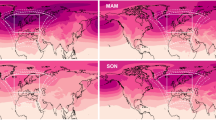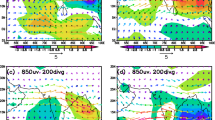Abstract
A seasonal analysis of the atmospheric circulation over the Iberian Peninsula (IP) based on circulation types (CTs) obtained from sea level pressure and 500-hPa geopotential height is presented. The study covers the period of 1958–2008, when a high variability and important changes in winter and spring precipitation and temperature have been reported. Frequency, persistence, and the most probable transitions of the circulation types are analyzed. Among the clustering methods available in the literature, two of the most reliable classification methods have been tested, K-means and simulated annealing and diversified randomization. A comparison of both methods over the IP is presented for winter (DJF). The quality of the circulation types obtained through both methods as well as the better stability achieved by K-means suggest this method as more appropriated for our target area. Twelve CTs were obtained for each season and were analyzed. The patterns obtained were regrouped in five general situations: anticyclonic, cyclonic, zonal, summertime, and hybrid-mixed. The analysis of frequencies of these situations offers a similar characterization of the atmospheric circulation that others previously obtained by subjective methods. The analysis of the trends in frequency and persistence for each CT shows few significant trends, mainly in winter and spring with a general decrease of the cyclonic patterns and an increase of the anticyclonic situations. This can be related to the negative precipitation trends reported by other authors. Regarding the persistence, an interesting result is that there is a high interannual variability of the persistence in autumn and spring, when patterns can persist longer than in other seasons. An analysis of the most probable transitions between the CTs has been performed, revealing the existence of cyclic sequences in all seasons. These sequences are related to the high frequency of certain patterns such as the anticyclonic situations in winter. Finally, a clear seasonal dependence of the transitions between cyclonic situations associated with extratropical disturbances was found. This dependence suggests that the transitions of low-pressure systems towards the south of the IP are more likely in spring and autumn than in winter.









Similar content being viewed by others
References
Bárdossy A, Caspary H (1990) Detection of climate change in Europe by analyzing European atmospheric circulation patterns from 1881 to 1989. Theor Appl Climatol 42:155–167
Beck C, Philipp A (2010) Evaluation and comparison of circulation type classifications for the European domain. Phys Chem Earth, Parts A/B/C 35(9–12):374–387. doi:10.1016/j.pce.2010.01.001
Bermejo M, Ancell R (2009) Observed changes in extreme temperatures over Spain during 1957–2002, using weather types. Rev Climatol 9:45–61
Bladé I, Cacho I, Castro-Díez Y, Gomis D, González-Sampériz P, Miguez-Macho G, Pérez F, Rodríguez-Fonseca B, Rodríguez-Puebla C, Sánchez E, Sotillo M, Valero-Garcés B, Vargas-Yáez M (2010) Clima en España: Pasado, presente y futuro. Tech rep, CLIVAR-España
Brunet M, Jones P, Sigró J, Saladié O, Aguilar E, Moberg A, Della-Marta P, Lister D, Walther A, López D (2007) Temporal and spatial temperature variability and change over Spain during 1850–2005. J Geophys Res 112:12,117
Calinski T, Harabasz J (1974) A dendrite method for cluster analysis. Commun Stat 3:1–27
Casado M, Pastor M, Doblas-Reyes F (2008) Euro-Atlantic circulation types and modes of variability in winter. Theor Appl Climatol 96:17–29
Cassou C, Terray L, Phillips A (2005) Tropical Atlantic influence on European heat waves. J Clim 18:2805–2811
Catell R (1966) The scree test for the number of pcs. Multivar Behav Res 1:245–276
Crane R, Barry R (1988) Comparison of the MSL synoptic pressure patterns of the Artic as observed and simulated by the GISS general circulation model. Meteoro Atmos Phys 39:169–183
Demezure M, Werner M, van Lipzig N, Roeckner E (2008) An analysis of present and future echam5 pressure fields using a classification of circulation patterns. Int J Climatol 29:1796–1810
Fereday D, Knight J, Scaife A, Folland C (2008) Cluster analysis of North Atlantic-European circulation types and links with tropical Pacific Sea surface temperatures. J Clim 21:3687–3703
Font-Tullot I (2000) Climatología de España y Portugal. University of Salamanca, Spain
Gallego F (1995) Situaciones de flujo mediterráneo y precipitaciones asociadas. aplicación a la predicción cuantitativa en la cuenca del segura. PhD thesis, Universidad de Murcia, Spain
García-Bustamante E, González-Rouco J, Navarro J, Xoplaki E, Jiménez P, Montávez J (2012) North Atlantic atmospheric circulation and surface wind in the northeast of the Iberian Peninsula: uncertainty and long term downscaled variability. Clim Dyn 38(1):141–160. doi:10.1007/s00382-010-0969-x
Gesterngarbe F, Werner P (1997) A method to estimate the statistical confidence of cluster separation. Theor Appl Climatol 57:103–110
Giorgi F (2006) Climate change hot-spots. Geophys Res Lett 33:08,707
Goodess C, Palutikof J (1998) Development of daily rainfall scenarios for Southeast Spain using a circulation-type approach to downscaling. Int J Climatol 18(10):1051–1083
Hannachi A, Jolliffe I, Stephenson D (2007) Empirical orthogonal functions and related techniques in atmospheric science: a review. Int J Climatol 27(9):1119–1152
Hartigan J, Wong M (1979) A k-means clustering algorithm. Appl Stat 28:100–108
Hess P, Brezowsky H (1952) Katalog der Grosswetterlagen Europas. Deutscher Wetterdienst in d. US-Zone
Hewitson B, Crane R (2002) Self-organizing maps: applications to synoptic climatology. Clim Res 22:13–26
Hulme H, Briffal K, Jones P, Senior C (1993) Validation of GCM control simulations using indices of daily airflow types over the British Isles. Clim Dyn 9:95–105
Huth R (1996) An intercomparison of computer-assisted circulation classification methods. Int J Climatol 16:893–922
Huth R (1997) Continental-scale circulation in the UKHI GCM. J Clim 10:1545–1561
Huth R (2000) A circulation classification scheme applicable in GCM studies. Theor Appl Climatol 67:1–18
James P (2007) An objective classification method for Hess and Brezowsky Grosswetterlagen over Europe. Theor Appl Climatol 88:17–42
Jiménez P, González-Rouco J, Montávez J, García-Bustamante E, Navarro J (2008) Climatology of wind patterns in the northeast of the Iberian Peninsula. Int J Climatol 29:501–525
Kaufman L, Rousseeuw P (1990) Finding groups in data: an introduction to cluster analysis, vol 39. Wiley Online Library, NY
Kendall M (1970) Rank correlation methods. Charles Griffin, London
Key J, Crane R (1986) A comparison of synoptic classification schemes based on objective procedures. Int J Climatol 6:375–388
Kirchhofer W (1974) Classification of European 500 mb patterns. Working reports of the Swiss Meteorological Institute, Swiss Meteorological Institute, Zurich
Kyselý J, Huth R (2006) Changes in atmospheric circulation over Europe detected by objective and subjective methods. Theor Appl Climatol 85:19–36
Lamb H (1950) Types and spells of weather around the year in the British Isles: annual trends, seasonal structure of the year, singularities. Q J Roy Meteor Soc 76:393–429
López-Bustins J, Martín-Vide J, Sánchez-Lorenzo A (2008) Iberia winter rainfall trends based upon changes in teleconnection and circulation patterns. Glob Planet Change 63:171–176
Lorenz E (1956) Technical report. Statistical forecast project report 1. Department of Meteorology. MIT 49, vol 1. Massachusetts Institute of Technology, chap Empirical orthogonal functions and statistical weather prediction, p 52
Lund I (1963) Map-pattern classification by statistical methods. J Appl Meteorol 2:56–65
Michelangeli P, Vautard R, Legras B (1995) Weather regimes: recurrence and quasi stationary. J Atmos Sci 52:1237–1256
Milligan G (1980) An examination of the effect of six types of error perturbation of fifteen clustering algorithms. Psychometrika 45:325–342
Paredes D, Trigo R, García-Herrera R, Trigo I (2006) Understanding precipitation changes in Iberia in early spring: weather typing and storm-tracking approaches. J Hydrometerol 7:101–113
Petisco E (2003) Metodología para una caracterización de la circulación atmosférica en el entorno de la Península Ibérica y Baleares.nt n 9. Tech rep, INM
Philipp A, Della-Marta P, JJacobett, Fereday D, Jones P, Moberg A, Wanner H (2006) Long-term variability of day North Atlantic-European pressure patterns since 1850 classified by simulated annealing clustering. J Clim 20:4065–4095
Philipp A, Bartholy J, Beck C, Erpicum M, Esteban P, Fettweis X, Huth R, James P, Jourdain S, Kreienkamp F, Krennert T, Lykoudis S, Michalides SC, Pianko-Kluczynska K, Post P, lvarez DR, Schiemann R, Spekat A, Tymvios FS (2010) Cost733cat a database of weather and circulation type classifications. Phys Chem Earth, Parts A/B/C 35(9–12):360–373. doi:10.1016/j.pce.2009.12.010
Preisendorfer R (1988) Principal components analysis in meteorology and oceanography. Elsevier Science Ltd, Amsterdam
Rasilla D (2003) Aplicación de un método de clasificación sinóptica a la Península Ibérica. Invest Geogr 30:27–44
Richman M (1981) Obliquely rotated principal componentes: an improved meteorological map typing technique. J Appl Meteorol 24:1145–1149
Romero R, Sumner G, Ramis C, Genovés A (1999) A classification of the atmospheric circulation patterns producing significant daily rainfall in the Spanish Mediterranean area. Int J Climatol 19:765–785
Sanchez-Gómez E, Terray L (2005) Largue scale atmospheric dynamics and local intense precipitation epidodes. Geophys Res Lett 32:24,711
Serrano A, Garcia J, Mateos V, Cancillo M, Garrido J (1999) Monthly modes of variation of precipitation over the Iberian Peninsula. J Clim 12:2894–2919
Storch V, Zwiers W (1999) Statistical analysis in climate research. In: Empirical ortogonal functions. Cambridge University Press, Cambridge. pp 135–192
Uppala S, Kallberg P, Simmons A, Andra U, da Costa Beechtold V, Fiorino M, Gibson J, Haseler J, Hernandez A, Kelly G, Li X, Onogi K, Saarinen S, Sokka N, Allan R, Andersson E, Arpe K, Balmaseda M, Beljaars A, van de Berg L, Bidlot J, Bormann N, Caires S, Chevallier F, Dethof A, Dragosavac M, Fisher M, Fuentes M, Sagemann, EH E, Hoskins B, Isaksen L, Janssen P, RJenne, McNally A, Mahfouf J, Mocrette J, Rayner N, Saunders R, Simon P, Sterl A, Trenberth K, AU A, Vasiljevic D, Viterbo P, Woollen J (2005) The era-40 re-analysis. Q J Roy Meteor Soc 131:2961–3012
Wang X (2008) Penalized maximal f test for detecting undocumented mean shift without trend change. J Atmos Oceanic Technol 25(3):368–384
Wilks D (1995) Statistical methods in the atmospheric sciencies: an introduction. International geophysics series, Academic Press, MA
Yiou P, Nogaj M (2004) Extreme climatic events and weather regimes over the North Atlantic: when and where? Geophys Res Lett 31:1–4
Yiou P, Goubanova K, Nogaj M (2008) Weather regime dependence of extre value statistics for summer temperature and precipitation. Nonlinear Process Geophys 15:365–378
Acknowledgements
This study received support from the Spanish Ministry of Environment (project ESCENA) and the Spanish Ministry of Science and Technology (projects SPEQMORE-CGL2008-06558-C02-02/CLI and SPEQTRES-CGL2011-29672-C02-02). J.J. Gomez-Navarro thanks the Spanish Ministry of Education for his Doctoral scholarship (AP2006-04100), and P. Jimenez-Guerrero thanks the Ramon y Cajal Programme of the Spanish Ministry of Science and Innovation. Thanks to Fidel Gonzalez-Rouco for the stimulating discussions. We would like to acknowledge the anonymous referees for their valuable comments, which improved the final version of this manuscript.
Author information
Authors and Affiliations
Corresponding author
Rights and permissions
About this article
Cite this article
García-Valero, J.A., Montavez, J.P., Jerez, S. et al. A seasonal study of the atmospheric dynamics over the Iberian Peninsula based on circulation types. Theor Appl Climatol 110, 291–310 (2012). https://doi.org/10.1007/s00704-012-0623-0
Received:
Accepted:
Published:
Issue Date:
DOI: https://doi.org/10.1007/s00704-012-0623-0




